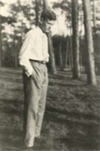I first saw his name, and only because of a mistake, in the bargain bin outside a Yugoslavian specialty bookstore in Klagenfurt, Austria, in 2007. This makes Germans laugh, though the cultural reasons why would take a long time to explain. Maybe it’s a bit like saying you saw Anne Frank’s name for the first time at a Spanish-language bookstore in Miami. Ingeborg Bachmann’s perfect autobiographical story “Youth in an Austrian Town” mentions a movie, Romance in a Minor Key, and I misremembered the title, thinking that this book, Comedy in a Minor Key, by Hans Keilson, was it. That was enough to make me pick up the book, I realized my mistake but bought the book anyway, and some three years later I had translated it into English and Hans Keilson, a former doctor in the Dutch Resistance and lifelong friend to children and all-around hero of the twentieth century, signed it for me in his house in Holland on the day before his hundredth birthday.
Hans Keilson’s life offers a useful warning about the ups and downs of literary fame, among other, more important lessons. His novel The Death of the Adversary was a best seller in the U.S. in 1962 and one of Time magazine’s top ten books of the year, in the staggering company of Faulkner’s last novel, Philip Roth’s first, Nabokov’s Pale Fire, Borges’s Labyrinths and Ficciones, Shirley Jackson’s We Have Always Lived in the Castle, Katherine Anne Porter’s Ship of Fools, Richard Hughes’s The Fox in the Attic, and J.F. Powers’s Morte d’Urban, plus one other dark horse (Frank Swinnerton’s Death of a Highbrow, his forty-ninth book). A Nobel Prize winner and three perennial Nobel candidates; four books and a fifth author now in the Library of America and two more books among the NYRB Classics; the year’s Pulitzer and National Book Award winners—and Keilson’s novel, which in 2007 and 2008 it was impossible to find even a description of on Amazon, on Wikipedia, on used-book sites, at the Harvard or Berkeley or Stanford libraries, or anywhere else I checked. Some terrible digitization of the Time archives made it impossible to find its review on Google. I was probably the only writer in America interested in Hans Keilson.
His name was known within academic psychology, thanks to his 1979 dissertation, Sequential Traumatization, the standard work in the field. (The full title is even more off-putting to nonspecialists: Sequential Traumatization in Children: A Descriptive-Clinical and Quantitative-Statistical Follow-Up Investigation of the Fate of Jewish War...
You have reached your article limit
Sign up for a digital subscription and continue reading all new issues, plus our entire archives, for just $1.50/month.
Already a subscriber? Sign in





